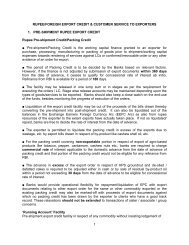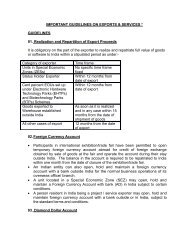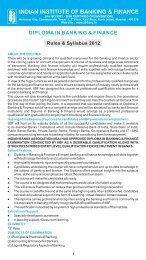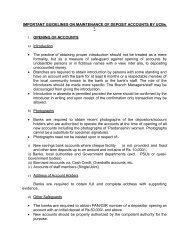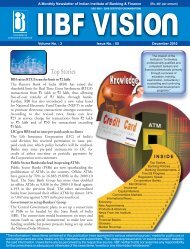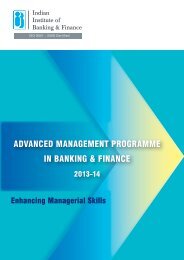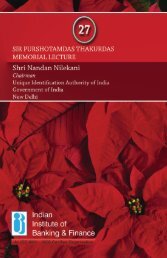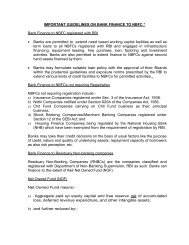Create successful ePaper yourself
Turn your PDF publications into a flip-book with our unique Google optimized e-Paper software.
1. Total Advances to Total Deposits :This ratio measures the efficiency and ability of thebank's management in converting the depositsavailable with the bank (excluding other funds likeequity capital, etc) into high earning advances. Totaldeposits include demand deposits, savings deposits,term deposits and deposits of other banks. Totaladvances also include receivables.2. Business Per Employee :This is an employee productivity measurementratio. This tool measures the efficiency of all theemployees of a bank in generating business forthe bank. It is arrived at by dividing the totalbusiness by the total number of employees. Bybusiness we mean the sum of Total Advances andTotal Deposits in a particular year. A higher ratio isconsidered better.3. Profit Per Employee :This ratio shows surplus earned per employee.It is arrived at by dividing the Profit after Tax(PAT) earned by the bank by the total numberof employees.Earnings QualityIt is important for any bank to have sustained resilienceto earn consistently in future. Earnings quality refersto the profitability and growth potential of earnings.Sustainability of earnings also depends on the share of“income from lending operations” in the total income,lending being the core activity of a bank. Of late, manybanks have seen much of their income coming throughnon-core activities like investments, treasury operationsand corporate advisory services etc. Earnings qualitycan be measured by the following ratios in terms ofincome generated by core activity-income from lendingoperations :1. Operating Profits to Average Working Funds Ratio :This ratio indicates how much a bank can earn(operating profit) from its operations net of theoperating expenses for every rupee of workingfunds. This is arrived at by dividing the operatingprofits by average working funds. Average workingspecial featurefunds is a daily average of total assets / liabilitiesduring a year. The higher the ratio, the better itis. An efficient utilization of funds will result inhigher operating profits. Banks with better abilityto use their assets efficiently will tend to have abetter average than the industry.2.Spread or Net Interest Margin to Total Assets :NIM is the difference between the interest income(including dividend income) and the interestexpended (including interest paid on deposits, loanfrom the RBI, and other short-term and long-termloans). as a percentage of total assets, shows theability of the bank to keep the interest on depositslow and interest on advances high. It is an importantmeasure of a bank's core income (income fromlending operations). A higher spread indicatesbetter earnings given the total assets.3. Net Profit to Average Assets :Profit to average assets indicates the efficiencyof the banks in utilizing their assets in generatingprofits. A higher ratio indicates the better incomegenerating capacity of the assets and betterefficiency of management. It is arrived at bydividing the net profit by average assets, which isthe average of total assets in the current year andprevious year. Thus this ratio measures the returnon assets employed. Higher ratio indicates betterearning potential in the future.4. Interest income to total income :This is yet another measure to assess bank's abilityto earn income from its core lending operations,expressed as a percentage of the total incomegenerated by the bank in a year. Interest income isthe basic source of revenue for a bank. Interestincome includes income on advances, interest ondeposits with the RBI and dividend income.5. Non-interest income to Total Income :Fee based income constitutes a lion's share ofa bank's other income. It is generated throughinnovative products and adopting the technologyfor value-added services. This stream of revenueThe Journal of Indian Institute of Banking & Finance October - December 2011 47



